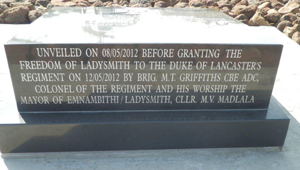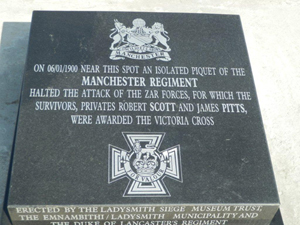Manchester Regiment Memorials
The Anglo Boer War 1899/1902
St Ann's Square, Manchester
Regimental South African War Memorial. The work of William Hamo Thorneycroft (1850 - 1925), it represents a soldier of the Manchester Regiment standing with bayonet fixed at the "ready" while a wounded comrade at his feet hands him a cartridge to continue the fight. The plinth represents a large rough rock, on the front face is a wreath of bay leaves. There are bronze plaques on all sides of the pedestal, three of which record the names of those who gave their lives in the War: 8 officers and 309 non-commissioned officers and men.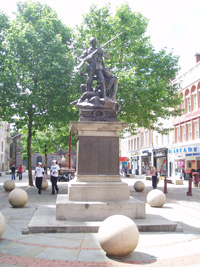
The inscription which runs around the four sides of the of the pedestal at the top reads:
To the memory of the following officers non-commisd officers and men who fell in the war in South Africa 1899-1902 gallantly serving their sovereign & country.
On the front at base is inscribed:
This monument is erected by public subscription.
A Memorial Committee was formed in the City of Manchester during 1902 to raise the necessary funds. On 26 October 1908 the memorial was dedicated by the Bishop of Manchester and unveiled by General Sir Ian Hamilton. The 2nd Battalion provided a Guard of Honour.
The memorial raised to the men of the Manchester Regiment, both regular army soldiers and volunteers from the Volunteer Battalions who died in the South African War was Manchester's first major outdoor war memorial. Calls for a memorial were made during the war itself following reports of the heroic actions of the Manchester Regiment, but it was felt that such an act would be premature. Towards the end of 1902 the regiment began to consider schemes to memorialise their fallen comrades. Proposals included an outdoor war memorial, a tablet in Manchester Cathedral and, more ambitiously, a soldiers' club.
The idea of the outdoor war memorial and a smaller memorial in the Cathedral was accepted. The initial proceedings of Manchester's Soldiers' War Memorial Fund were uncontroversial as the committee set about raising £2,000, the sum that had been set as necessary to realise the project. By January 1904 over £1,900 had been subscribed and discussions turned to the question of selecting the sculptor. A limited competition appeared to be the way forward and the Executive Committee recommended that six sculptors - Frampton, William Hamo Thornycroft, Henry Pegram, Alfred Drury, Frederick Pomeroy and John Cassidy should be invited to submit designs. This recommendation was not accepted by the General Committee, which decided to appoint Thornycroft.
The decision upset many subscribers who felt that there should have been an open competition: 'the narrowest and worst form of Protection, unworthy of a broad-minded, progressive, Free Trade city like Manchester.' More particularly, there was a group of subscribers keen that the memorial should be awarded to the Manchester sculptor, John Cassidy. They used the press to draw attention to the committee's decision, clearly unhappy at what they regarded as the dishonourable behaviour of Thornycroft supporters on the committee.
A special private meeting of the committee was called by the Lord Mayor to examine the case but in the end the decision stood. Thornycroft was to be the sculptor though in what was to be another area of dissatisfaction among committee members, it was announced that because of his other commissions, he would not be able to complete the memorial for two and a half years. His supporters, however, did not forget Cassidy, and he was commissioned privately to produce a war memorial.
When Thornycroft eventually began work on the memorial he produced a composition based on an incident during one of the regiment's most celebrated engagements, the fighting at Caesar’s Camp, Ladysmith. Entitled 'Comrades', it depicted two life-size figures, one soldier standing over a wounded colleague who is offering a cartridge to continue the fight. Two soldiers from the regiment were used as the models; one of whom was Captain Edmund Nelson Fisher, whose family was later presented with a bust based on the statue.
The location of the memorial was still undecided in 1907 when the memorial committee approached the Corporation's Town Hall Committee to discuss the possibility of siting it in Albert Square, particularly as the removal of the jubilee fountain was being contemplated. It was suggested that either the war memorial might be placed on the site of the fountain or, if that was not suitable, then the Bishop Fraser statue could be moved there, allowing the war memorial to be located on the edge of the square. However the Town Hall Committee ruled out Albert Square.
Further discussions followed before the council and the committee agreed on St Ann's Square. Local shopkeepers campaigning to improve the square welcomed the idea of the memorial. Thornycroft had been right to make it clear that the memorial could not be completed quickly. The memorial was not to be finally completed until 1908. It was cast at Singer's foundry at Frome. As the long awaited inauguration was finally being arranged - Salford's memorial had been unveiled three years before - a further appeal for funds to reduce the outstanding deficit of £350. Manchester's principal South African War memorial was unveiled in October 1908, almost six years since the start of the discussions to raise a memorial. General Sir Ian Hamilton recalled the heroic deeds of the Manchester Regiment in South Africa including their battle at Elandslaagte before he removed the Union Jack covering the memorial.
Thornycroft's depiction of the dramatic episode in the war found widespread approval, a sculpture that could be regarded as an important addition to the city's collection of public monuments. In the words of the Manchester Guardian, it was a work that was 'dignified, impressive and rich with virile beauty.’ But had journalists made a closer study of the sculpture particularly the names identified on the list they would have discovered that not all those in the war were recorded.
The war memorial became a place of remembrance for the regiment on Elandslaagte Day (October 21) and later on Remembrance Day. Throughout the more recent changes made to the layout of St Ann's Square, the memorial has remained in its original position, the granite protectors at the corners of the pedestal a reminder of a time when wheeled traffic filled the square.
Manchester Cathedral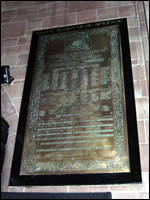
Located in the West Porch, a very large brass plaque within a black frame commemorating the names of those men of all Manchester Regiment Battalions who died in the Boer War.
At the top of the frame is the line from Horace: Dulce et decorum es pro patria mori (It is sweet and comely to die for fatherland). Around the tablet is a border of rose leaves and in each corner is a rose. Beneath the arms of the city is the inscription: To the glory of God and in grateful commemoration of the following officers and men who fell in South Africa in 1899-1902, gallantly serving their Sovereign and country, this tablet is erected by public subscription.
Then are engraved the names of those who fell in the following order:
Manchester Regiment 1st Battalion, 2nd Battalion, 5th Militia Battalion, 6th Militia Battalion and the six Volunteer Battalions who served with the 1st & 2nd Battalions.
Then follow the 7th Lancashire (Manchester) Battery Royal Garrison Artillery, Royal Army Medical Corps (Volunteers) and the 77th (Manchester) Company Imperial Yeomanry.
South Africa, Caesars CampStone memorial in memory of those of 1st Manchesters who fell in the defence of Ladysmith in 1899. Built during the war. Refurbished in 1999 with funds raised by the Manchester Regiment Officers Association and friends. |
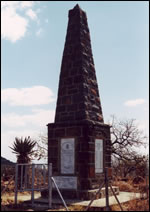 |
South Africa, LadysmithStone Memorial in town listing names of all casualties during the siege. |
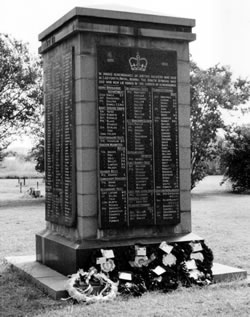 |
South Africa, ElandslaagteStone memorial on the battlefield to the men of 1st Manchesters who died in the battle of 21 October 1899. |
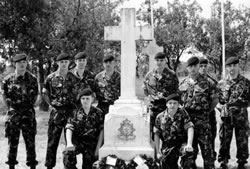 |
 South Africa, Elandspruit
South Africa, Elandspruit
Memorial in a small graveyard situated on a rocky hillside approximately 20 km from Dullstroom on the Road to Lydenburg in the Eastern Transvaal. The memorial is in white stone and consists of a large square block on a larger base surmounted by a large cross with words Honour the Brave carved horizontally. On the back face is the regimental badge of the Brunswick Star containing the fleur de lys and underneath the scroll First Battalion.
Erected by all ranks of the 1st Battn Manchester Regiment in affectionate memory of their comrades who were killed or died of wounds received in action near this spot on the night of the 19th December 1901.
Died and buried near this place Sergeants F Ford, A Davis, Ptes W Frost, R Brunditt, R Redford. H Holmes, B Bohin Died of wounds and buried elsewhere Major A T P Hudson, Colour Sergeant T Marten, Pte W Fleet
South Africa, Eastern Transvaal
Memorial at Barberton (Mpumalanga) commemorating Corporal W Woodcock and Private J Hines.
South Africa, Hatheringsdal
Memorial in the shape of a cross commemorating the deaths on 6 November 1901 of Privates Ishmael, Taylor and Bates of the 3rd Volunteer Service Company serving with 2nd Manchesters.
South Africa, Langberg
Memorial in the shape of a cross commemorating the death on 12 November 1901 of Captain C J H Noble of the Mounted Infantry Company, 2nd Manchesters.
South Africa, Lydenburg area
Memorial to Private Joseph Gilligan, Mounted Infantry Company 2nd Manchesters who died 1 October 1901.
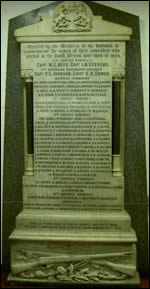 Ardwick Green Barracks, Manchester
Ardwick Green Barracks, Manchester
Marble Wall Memorial recording the names of all those who served with the Volunteer Service Sections and other units provided by the Ardwick Battalion.
Volunteer Service Companies
Those of the Ardwick Battalion (5th Volunteer Battalion) who served:
1st Service Company (Reserve Section)
Sergeants William H Smith, Alfred Henry Walmsley, Herbert Dunn.
Corporal Hugh McClughan, Privates William Brock i, F A Browning ii, William Maloney iii, Mark Whitehead, John Stirling iv, John West v
2nd Service Company
Captain W G Heys, Captain I M Stevens
Colour Sergeant William Hobson vi, Sergeant Alexander Crawford
Corporals Herbert Greenhalgh, Drummer Thomas Gibson (Medical Orderly)
Privates James John Barber, Walter Chisholm Broomfield vii, Albert Bennett, T Valentine Broomhead, William Butler, Albert Clarke, William H Corlett, Henry Davis, John Charles Davies, Walter Edwards, Arthur Elsden, George H Foster John Gleeson, William Griffin, John Gunshon, William Henry Hardy, Walter Higginson viii, Simeon Holden, Arthur Holmes, John W Hulme, Harold Hume, Joseph Jervis William Jones 49, William Jones 27, Herbert Lancashire, Joseph Leigh, James Albert Lord, Arthur Magowen, Robert McCarthy George McMullen, James A Park, David Parker, John T Parman, John H Parnell, John J Parry, Alfred Peach, James T Preston, Thomas Pritchard, John Redman Abraham Reeves, James Sangster John J Sellers, George E Sharples, Albert Simpson, James Smith, James Taplin, John Urwin, Ernest M Ward, E M Ward, Herbert Waterhouse, Thomas West, Mark Whitehead, Henry Willan
3rd Service Company
Privates James M Barker, Frederick Brade, William Brown, John Carter, Robert William Dooley, Richard Frederick Fish, W H Ghent, Joseph Hibbs, 8353 F Hulley, Thomas Edward Jones ix, Samuel Leech, 8352 P Mangnall, J W Marland x, Robert Arthur Mitchell, John Unsworth, Charles Henry Wood xi, Thomas Woods xii
4th Service Company xiii
Corporal Hugh McClughan, Lance Corporal J Rakeshaw
Privates William Hartley, William Maloney, William Milner
Imperial Yeomanry
(32nd, 77th & 105th Companies)
Privates Frederick Brade, William Brown, Richard Fred Fish, Joseph Hibbs, Thomas E Jones, John Unsworth
William Aldcroft, Richard Butler, J H Code, Theodore Cole, Alfred Dell, John Hood xiv, John Renshaw, Edmund Alexander Rowson, John E C Royle, Ralph Dean Stott, John Henry Swift, George Tarrant, Thomas William Woolwich, Alfred Ernest Wood, George Warwick
No 10 General Hospital RAMC
Sergeants Alexander Hughes, W Stapleton, Mark Wood xv
Corporal Frederick W Circuit
Privates James Bibby, George Coyle, Charles Graham, Alfred Warburton
Volunteers who served with other RAMC units
Privates Edward Bradford Bayley, Edward Davies, C Hudson, A Hughes, G King Robert Laverty, William Taylor
_________________
- 7132 Pte William Brock. Invalided home.
- 7124 Pte F A Browning died of enteric fever in March 1901. Buried Germiston, Primrose.
- 7138 Pte Wm Maloney. Later Corporal The Duke of Edinburgh’s Own Volunteer Rifles.
- 7139 Pte John Stirling was wounded at Bergendal on 27 August 1900
- 7120 Pte John West was invalided home.
- 7113 C/Sergeant W Hobson. Various papers are held in the Archives: MR3/17/104 & MR1/17/11.
- 7161 Pte W C Broomfield. His medals are in the Manchester Regiment Museum collection.
- 7154 Pte Walter Higginson. A married man. Father lived at 1 Oldfield Road, Salford.
- 8355 Pte T E Jones joined the Johannesburg Police on 28 August 1901.
- 8354 Pte J W Marland. His medals are in the Museum of The Manchester Regiment.
- 8258 Pte C H Wood. Remained in South Africa.
- 8359 Pte T Woods was invalided home from Harrismith. He rejoined at Ardwick in February 1902.
- McClughlan and Maloney had already been to South Africa with the 1st VSC
- John Hood. Medically discharged 21 February 1902.
- Sergeant Mark Wood. Died of enteric fever 15 August 1900.
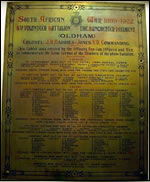 Ardwick Green Barracks, Manchester
Ardwick Green Barracks, Manchester
Brass Memorial recording the names of all those who served with the South Africa Volunteer Service Sections provided by the Oldham Battalion in the Boer War. Previously in the Rifle Street, Oldham Drill Hall.
Volunteer Service Companies
Those of the Oldham Battalion (6th Volunteer Battalion) who served:
1st Service Company
Captain P Bamford
Sergeant J H Barr i, Privates G H Bowden, W Dolphyn, William Emmott, T Kershaw ii, H Ogden, A Taylor, P Taylor, T Wadsworth, R Weston
2nd Service Company
Lieutenant G W Hardman
Sergeants C Dunkerley, H Jackson, J Mulcaster iii
Corporals Alfred Caley iv, J R Street, Lance Corporals F Dunkerley & F Williams
Drummer J Black, Privates Frank Andrew, G Armstrong, G A Ashworth, A Bancroft, James John Barber, J Bell, J Bowman, C Buckley, J Buckley v, R Cash, J Chadwick, J Coglan, S Collier, J Conway, Joseph Cubby, J Curran, C Dunkerley, Thomas Ebdon, H Garland, A Glover, G Goodwin, S Greenhalgh, William Halkyard, R Hall, Thomas A Hankinson, J T Heron, J Hibbert, E Holden, J Houlston, J Kiernan, E Lane, R Lees, J Marcroft, Adam McConnochie, Philip Papworth, A Prescott, E Rhodes, H Royle, T Schofield, W H Schofield, E Smith, W Steeple, H V Summersgill, G Tattersall, J Trevitt, J Walne, R Waugh, T Whitehead, H Whittaker, J S Wood, J W Wood
3rd Service Company
Colour Sergeant W Bailey, Corporal W Davies
Privates J Byron, C Collins vi, J E Goodwin, Edward Smith vii, J Wolstencroft
4th Service Company
Lance Corporal J J Cheetham,
Privates H Barber, T H Bardsley, H Belshaw, W Clegg, C G Cole, G Davies, Edward Drinkwater, John Gilham, F Harding, C Hardman, H Harrison, W Hoddy, W Hoyle, D Hunt, J Insull, J Marsden, E Mellor, H Mellors, P W Orris, J Rhodes, W Roebuck, John J Seddon, E F Strandring, H Stott, S E Stott, A J Taylor, R Taylor, W Taylor, H Turner, Fred Winterburn viii, William Whyatt
Imperial Yeomanry
Sergeant W Chadderton, Sergeant G Marsden
Corporal A H Priestley, Privates F Newton & G Pownall
23rd (Duke of Lancaster’s) Company, Imperial Yeomanry
Private F Thompson
RAMC
Sergeant F Howarth, Privates E Barber, J Booth, T Lewis, W Lewis, R Neilson
JJ Nelson, J Nightingale ix, J J Shackleton
The St John’s Ambulance
Privates T Bennett, H Hollins, J S Lees,T S Greenwood
_________________
- Sergeant Barr. Discharged in South Africa on 1 April 1901 to join the Imperial Military Railway.
- T Kershaw 7181. Discharged on 1 December 1900 to join the Imperial Military Railway.
- Colour Sergeant J Mulcaster. His medals are in the Manchester Regiment Museum collection.
- 171 Corporal Alfred Caley. Home at 228 Shaw Road, Oldham. A cotton mill packer. Born 1880
- 8251 James Buckley, born Heywood, home at 9 Sidle St, Oldham. Wife was Mary J Buckley & his daughter was Bertha.
- Pte C Collins taken prisoner on 6 November 1901 and later released.
- 8347 Pte E Smith. Transferred to the Johannesburg Police.
- 8456 Pte F Winterburn. Born 1883 at Shaw, Oldham. A spun-cotton mule piecer. In lodgings at 68 Alfred Street, Crompton, Shaw.
- Private J Nightingale died of disease
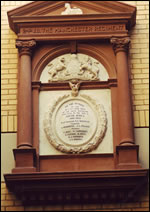 University Barracks, Manchester
University Barracks, Manchester
Large stone and marble monument built into wall of drill hall, to the memory of the NCOs and men of the 2nd Volunteer Battalion (Stretford Road) who died in South Africa whilst serving with the Volunteer Service Companies of the Regiment.
A large wall memorial in red stone containing an inner marble plaque of white marble with stone pillars on each side. A triangular pediment containing a carved white marble sphinx, underneath which is carved
2nd VB The Manchester Regiment.
The inner marble plaque is surmounted by the carved marble Coat of Arms of Manchester below which is a carved winged bird. Underneath contained within a circular wreath:
To the memory of the NCOs and MEN of the above battalion who fell in the war in SOUTH AFRICA 1899 - 1902
Staff Sergeant F C Sharples / Corporals J Monkhouse, J L Pollock / Privates S Bent, W Carmichael, G Cocker, H Oxley, E J Unsworth, J A Winning
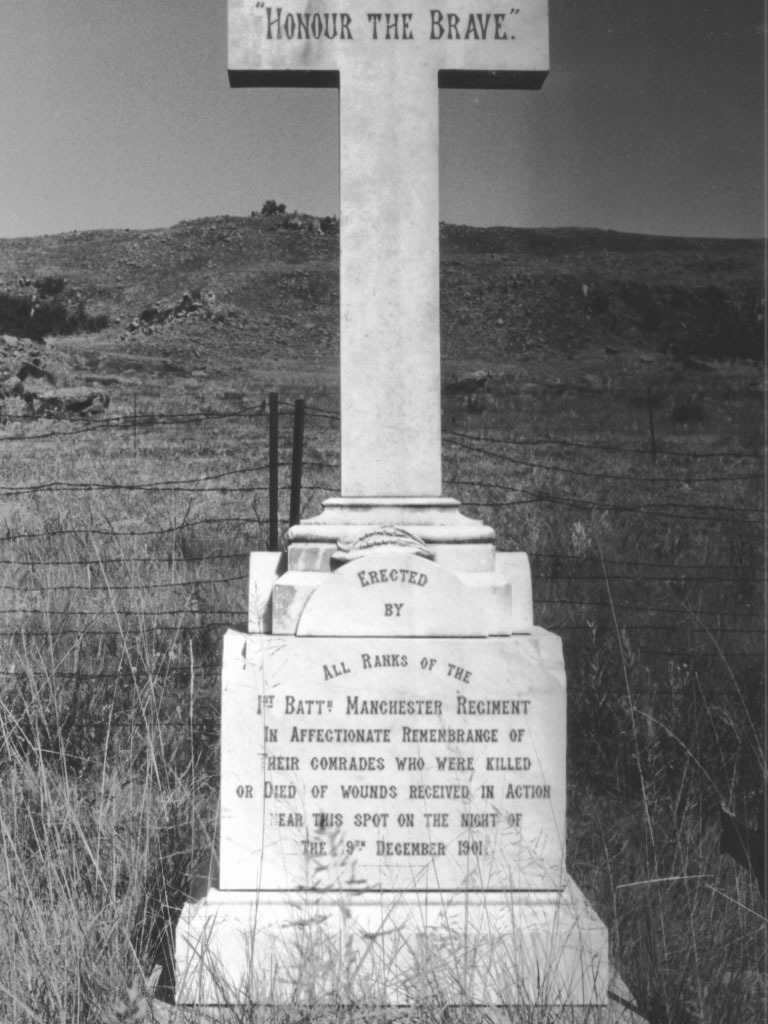 South Africa, Pretoria, South Africa
South Africa, Pretoria, South Africa
Sited in the cemetery, 'Honour the Brave’. A Large white cross on base.
Erected by the officers 'H’Company 1st Manchesters.
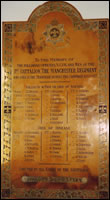 St John’s Church, Lydenburg, Pretoria, South Africa
St John’s Church, Lydenburg, Pretoria, South Africa
Fine engraved brass plaque. A finely engraved border of roses and leaves with the numbers 63 in each corner. Top centre an engraved Brunswick Star containing the fleur de lys. Below the star is a scroll 'First Battalion’.
To the memory of the following Officers, NCOs and men of the 1st Battalion The Manchester Regiment who died in the Transvaal during the campaign 1900-02
Killed in action or died of wounds.
Major A T P Hudson, Captain A Menzies, Captain J E T Crighton
Cl-Sgt T Martin, Sergt F Ford, Sergt A Davies, Sergt H Chandler, L/Cpl F Munro
Pte J Holland, J Evans, J Barnes, T Comerford, J Lally, T Fisher, R Williams, J Salt, A Gilligan, R Stewart, J Lewis, R Redford, W Frost, W Brundritt, P Bohin, H Holmes, W Fleet
Died of Disease
Sergeant J Croasdale, Lc Cpl G Gilder
Pte K Ball, J Sutcliffe, J Turnbull, G Wren, R Jones, J Quinn, J Martin, J Patrick,
J Conroy, W Morton, W Cook, J Connell, J Mannion, G Smith, J Makin, W Schofield, J Green, C Buckingham, J Walsh, J Case
Erected by all ranks of the Battalion
Honour the Brave
South Africa, Ladysmith Church
Engraved brass plaque listing the casualties of 1st Manchesters during the siege.
 University Barracks, Manchester
University Barracks, Manchester
Plain stone plaque containing the names of all those from the Stretford Road Battalion (2nd Volunteer Battalion) who served in the Boer War. Now built into the inside of an exterior wall to University Barracks.
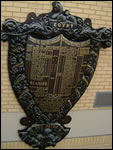 University Barracks, Manchester
University Barracks, Manchester
A large ornately carved wooden shield surmounted with the sphinx and at the base of the centre panel a fleur de lys in gold above the words Pro Patria.
Town Hall, Wigan, Lancashire
A commemorative marble plaque to the three men of the1st Volunteer Battalion who were killed in action during the Anglo Boer War: Munro, Ball and Batey.
Bardsley Parish Church, Ashton-under-Lyne
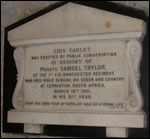 A memorial tablet to Private Samuel Taylor of the 3rd Volunteer Battalion who had served in South Africa with the 1st Volunteer Service Company attached to 1st Manchesters. He died in South Africa of enteric fever and is buried in Germiston Cemetery. The tablet was unveiled by Mr E Lees of Park Bridge and is of white marble on a ground of black marble.
A memorial tablet to Private Samuel Taylor of the 3rd Volunteer Battalion who had served in South Africa with the 1st Volunteer Service Company attached to 1st Manchesters. He died in South Africa of enteric fever and is buried in Germiston Cemetery. The tablet was unveiled by Mr E Lees of Park Bridge and is of white marble on a ground of black marble.
This tablet was erected by public subscription in memory of Private Samuel Taylor of the 3rd VB Manchester Regiment who died whilst serving his Queen and country at Germiston, in South Africa, March19th 1901, in his 31st year; lay hold on eternal life
Mesnes Park, Wigan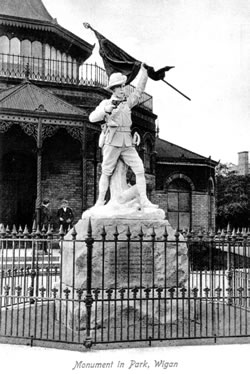
A life size statue of an officer of a Volunteer Service Company carrying a revolver in his right hand and raising aloft a standard with his left hand was built after the war. Unfortunately vandals gradually destroyed the monument and all that remains today is the large piece of granite on which the statue stood. The sculptor was John William Gascombe and the memorial was unveiled on 4 February 1903.
St Paul’s Church, Morton, Lincolnshire 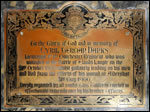
South Wall. Commemorative plaque to Lieutenant Cyril German Danks.
1st Battalion. Died of wounds at Aldershot 31 May 1900 received at Elandslaagte.
St Paul’s Church, Morton, Lincolnshire
Churchyard. Commemorative cross to Lieutenant C G Danks.
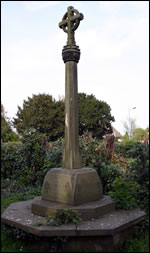
Clyro Parish Church, Powys
Brass plaque. Captain John Ernest Theodore Crighton. 1st Battalion.
Killed in action at Schwarz Kopje, Belfast, South Africa 14 February 1901.
Borough Cemetery, Prestbury, Gloucestershire
Memorial to Captain George Frederick Wallace Brindley. 2nd Battalion. Died of wounds at Holland, South Africa 19 December 1901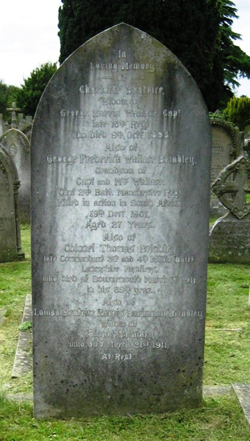
In Loving Memory of Charlotte Beatrice widow of George Harris Wallace Cpt. late 16th Regt. who died 9 Oct. 1893 Also of George Frederick Wallace Brindley Grandson of Capt. and Mrs. Wallace Capt. 2nd Batt.Manchester Regiment Killed in action in South Africa 19th Dec. 1901 Aged 27 years Also of Colonel Thomas Brindley late commandant 3rd and 4th Militia Batts Lancashire Fusiliers who died at Bournemouth March 1st 1911 in his 69th year Also of Louisa Beatrice Harris Buchanan Brindley widow of Colonel Brindley who died March 21st 1911. At rest
Hawke’s Bay, New Zealand
Marble wall tablet:
Erected by the people of Hawke’s Bay to commemorate the part taken by troopers from this district in the South African War 1899 to 1902. And as a tribute to the patriotism shown by them in offering their services in the empire’s cause.
Lieut O H M Hovell Later Lieut Manchester Reg
Blackley Wesleyan Day School Old Boys Association Memorial
Black tablet with gold engravings housed at the Lancashire Fusilier’s Museum. 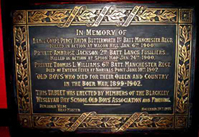 Commemorates two soldiers of the Manchester Regiment – Lance Corporal Percy Haydn Butterworth, 1st Battalion, killed at Wagon Hill during the Battle of Ladysmith, January 6th 1900, and Private Thomas L. Williams, 6th Battalion, died of enteric fever at Norvalspont on June 10th 1902, ten days after the war ended. It also commemorates a soldier from the 2nd Battalion of the Lancashire Fusiliers; Private Ambrose Jackson, who was killed during the Battle of Spion Kop, January 24th 1900. Members of the Blackley Wesleyan Day School Old Boys Association erected the tablet on the 7th of November 1998.
Commemorates two soldiers of the Manchester Regiment – Lance Corporal Percy Haydn Butterworth, 1st Battalion, killed at Wagon Hill during the Battle of Ladysmith, January 6th 1900, and Private Thomas L. Williams, 6th Battalion, died of enteric fever at Norvalspont on June 10th 1902, ten days after the war ended. It also commemorates a soldier from the 2nd Battalion of the Lancashire Fusiliers; Private Ambrose Jackson, who was killed during the Battle of Spion Kop, January 24th 1900. Members of the Blackley Wesleyan Day School Old Boys Association erected the tablet on the 7th of November 1998.
Lees Cemetery, Thomas Street, Lees, Oldham
The Memorial Reads as follows: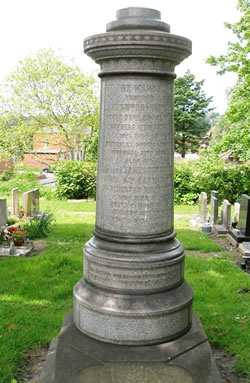
To the memory of Trooper James William Dransfield of the 23rd Imperial Yeomanry who died at Kimberley, South Africa November 27th 1900 and also Private James Brennan of the 5th Battalion The Manchester Regiment who died at Netley Hospital January 10th 1902 after being invalided home form South Africa
Around the base it reads:
The memorial was erected by subscribers to the Lees South African War Fund August 15th 1903
Memorial Tablet to Corporal Bugler G. Henshaw
This memorial tablet reads:
“In memory of Corporal Bugler G. Henshaw who volunteered with the First Active Service Section January 1900 and died August 15th 1902 from disease contracted in the South African War aged 26 years. This tablet was erected by the officers, non-commissioned officers and men of G and K Companies 1st Vol. Batt. Manchester Regiment”.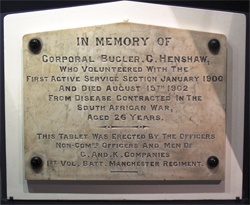
The plaque was removed in September 2005 prior to the redevelopment of the Eccles Drill Hall.
This tablet was donated to the Museum of the Manchester Regiment, in March 2011, by the trustees of the Eccles Drill Hall where it was first installed after being commissioned.
Memorial Tablet to Pitts and Scott VC
“On 06/01/1900 near this spot an isolated piquet of the Manchester Regiment halted the attack of the Zar forces, for which the survivors, Privates Robert Scott and James Pitt, were awarded the Victoria Cross”.
“Unveiled on 08/05/12 before granting the freedom of Ladysmith to the Duke of Lancaster’s Regiment on 12/05/2012 by Brig. MT Griffiths CBE ADC, Colonel of the Regiment and his worship the Mayor of Emnambithi-Ladysmith, Cllr MV Madlala”.
